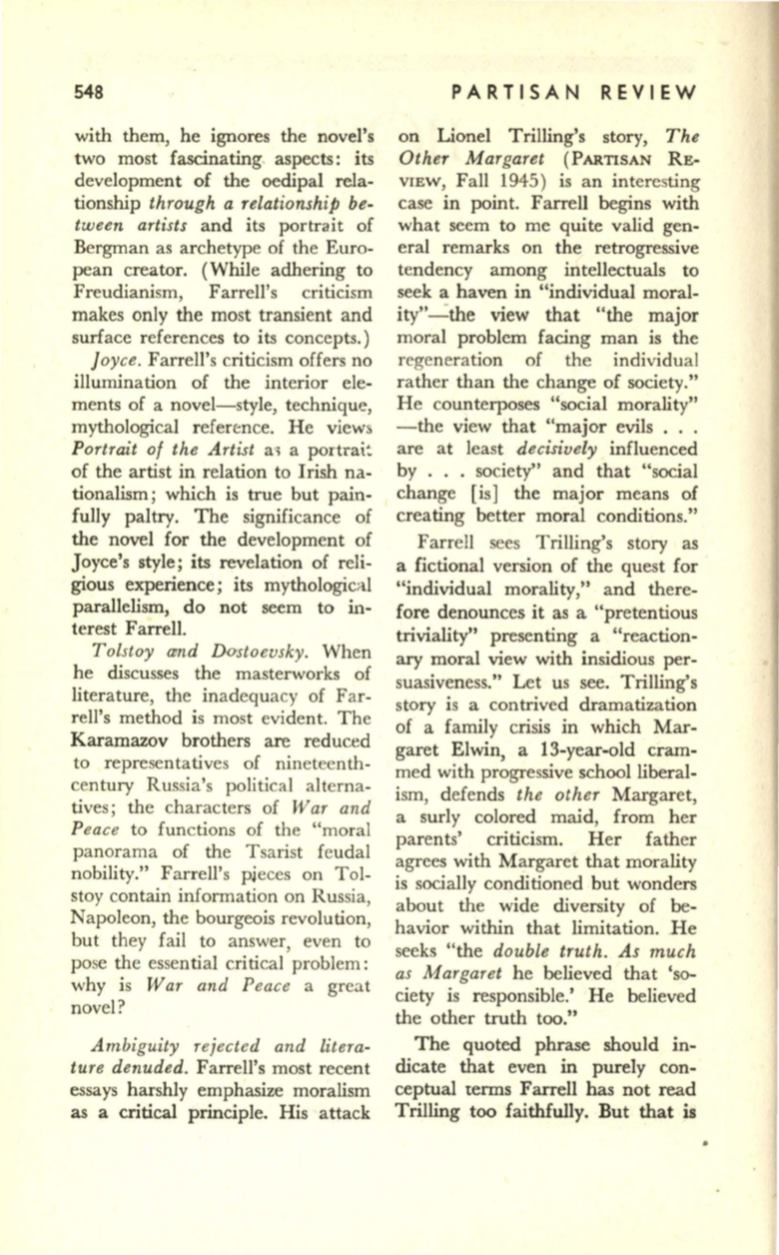
548
with them, he ignores the novel's
two most fascinating, aspects: its
development of the oedipal rela–
tionship
through a relationship be–
tween artists
and its portrait of
Bergman as archetype of the Euro–
pean creator. (While adhering to
Freudianism, Farrell's criticism
makes only the most transient and
surface references to its concepts.)
Joyce.
Farrell's criticism offers no
illumination of the interior ele–
ments of a novel-style, technique,
mythological reference. He views
Portrait of the Artist
a·; a
portrai~
of the artist in relation to Irish na–
tionalism; which is true but pain–
fully paltry. The significance of
the novel for the development of
Joyce's style; its revelation of reli–
gious experience; its mythologic:.tl
parallelism, do not seem to in–
terest Farrell.
Tolstoy and Dostoevsky.
When
he discusses the masterworks of
literature, the inadequacy of Far–
rell's method is most evident. The
Karamazov brothers are reduced
to representatives of nineteenth–
century Russia's political alterna–
tives; the characters of
War and
Peace
to functions of the "moral
panorama of the Tsarist feudal
nobility." Farrell's pjeces on Tol–
stoy contain information on Russia,
Napoleon, the bourgeois revolution,
but they fail to answer, even to
pose the essential critical problem:
why is
War and Peace
a great
novel?
Ambiguity rejected and litera–
ture denuded.
Farrell's most recent
essays harshly emphasize moralism
as a critical principle. His attack
PARTISAN REVIEW
on Lionel Trilling's story,
The
Other Margaret
(PARTISAN RE–
VIEW,
Fall 1945) is an interesting
case in point. Farrell begins with
what seem to me quite valid gen–
eral remarks on the retrogressive
tendency among intellectuals to
seek a haven in "individual moral–
ity"_:the view that "the major
moral problem facing man is the
regeneration of the individual
rather than the change of society."
He counterposes "social morality"
-the view that "major evils . . .
are at least
decisively
influenced
by ... society" and that "social
change [is] the major means of
creating better moral conditions."
Farrell sees Trilling's story as
a fictional version of the quest for
"individual morality," and there–
fore denounces it as a "pretentious
triviality" presenting a "reaction–
ary
moral view with insidious per–
suasiveness." Let us see. Trilling's
story is a contrived dramatization
of a family crisis in which Mar–
garet Elwin, a 13-year-old cram–
med with progressive school liberal–
ism, defends
the other
Margaret,
a surly colored maid, from her
parents' criticism. Her father
agrees with Margaret that morality
is socially conditioned but wonders
about the wide diversity of be–
havior within that limitation. He
seeks "the
double truth. As much
as Margaret
he believed that 'so–
ciety is responsible.' He believed
the other truth too."
The quoted phrase should in–
dicate that even
in
purely con–
ceptual terms Farrell has not read
Trilling too faithfully. But that is


